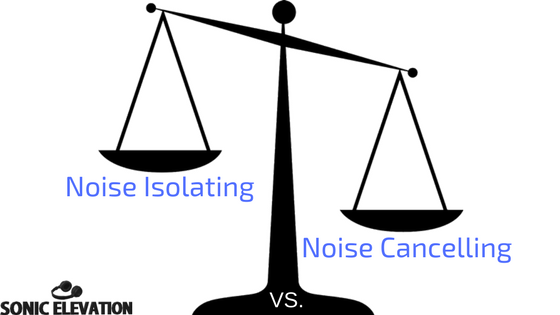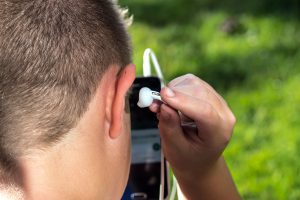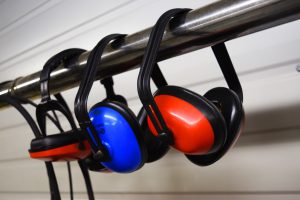
Explaining Noise Isolating vs Noise Cancelling
When it comes to the different styles of headphones used to block out background noise, there are two main designs built to do that. Noise-cancelling headphones have been pretty popular for a while now. Noise-isolating headphones, on the other hand, tend to have more confusion surrounding them.
Are they the same thing? Which one will keep the noise out better? We’ll go through each style separately, then compare Noise Isolating vs Noise Cancelling. You’ll be able to explain the difference between the two like a true audiophile.
Noise Isolating vs. Noise Cancelling
What’s the difference? The basic answer lies in the actual design of each respective headphone.
Noise-isolating and cancelling headphones come in different shapes and sizes. Noise isolating ‘phones rely on the building design to keep noise out. On the flip side, instead of just relying on the building design – headphones with ANC (active noise cancelling) have special technology for that purpose.

Noise Isolating Headphones
This style of ambient noise-blocking can be featured in around-ear, over-ear, in-ear, and in-ear monitors (aka IEMs).
Since most in-ears/earbuds actually fit inside your ear canal, the mechanism is similar to wearing a pair of earplugs. The main difference is that you’ll be playing music at the same time.

Earplugs That Play Music – (And Block Noise)
The earplug-style not only makes your music sound fuller and more bass-heavy but also acts as a form of passive noise isolation. It’s considered “passive” because you’re not actively doing anything extra to block out background noise (and neither are the headphones/earbuds.)
This style of headphone usually tends to be a little bit less expensive. (That is unless you really want to go deep and get some custom-molded IEMs.)
Some people prefer this style (especially for listening in public) since they’re more compact, discreet, and easy to carry around.
Over/On-Ear Headphones
Over-ear headphones that utilize an around-ear build will also keep barking dogs from interrupting your favorite song. They do this by making a pair of ‘phones that goes around (or on) your ears – instead of inside them.
The ear cups will sit over your ears and form a tight seal between the padding and your skull. If you’ve ever used a weed trimmer, chainsaw, or gone to a shooting range you know how important ear protection can be.

The earmuff headset that you wear when you’re working with loud machinery uses passive noise isolation to protect your ears. When it comes to over/on-ear headphones, they use the same exact build design but for a different reason.
Just like the in-ear headphones and earbuds, they keep the sound of your music isolated to your ears, so you can listen in peace. Some people prefer this design over the in-ear/earbud-style because they fit better on their ears. (It’s really a matter of preference.)
Noise Cancelling Headphones
Noise cancellation technology will often automatically switch on when you power up your headphones. Other models give you the option to press a button or touchpad control in order to activate it.
There are a few different kinds of technology. (They will usually be abbreviated as ANC on your headphone packaging or the companies site.)
- Active Noise Cancellation
- Hybrid Noise Cancellation
- Adaptive Noise Cancellation
Active NC – Feedforward and Feedback ANC
There are also 2 different forms of Active NC. The first is called Feedforward ANC. Headphones with this version will have a built-in mic on the outside of an ear cup. When the mic (on the outside) senses the noise outside of your headphones – it sends a counteractive signal in the opposite direction. This is sometimes called “anti-noise”.
Feedforward ANC is better at getting rid of lower frequencies in the range of about – 1 to 2 kHz.
The second kind is called Feedback ANC. This style features a mic on the inside of the ear cup and on the front of the speaker. Feedback ANC is able to cancel out a broader range of frequencies than Feedforward ANC.
It does have a few downsides. For one, it has a harder time handling high-range frequencies. Two, it alters the sound of your music (since the ANC signals are mixed in with your audio). Sometimes this results in a sound that’s similar to the sound a mic makes when it’s too close to the loudspeaker.
Hybrid ANC
Hybrid models usually involve a combination of two good elements to make something better – yup, you guessed it. This style takes notes from the Feedforward AND Feedback ANC.
A microphone will be fixed on the outside of your ear cup, and on the inside. Due to the combining of mic placement – your headphones will be able to block out a wider range of frequencies.
Like pretty much anything hybrid, you’ll usually have to fork out a few more dollars to reap the benefits of Hybrid ANC. (We all know how expensive a brand new environmentally-friendly hybrid car can be.)

Adaptive NC
Adaptive Noise Cancellation will do exactly what it sounds like it will. It will use similar mechanisms to the styles above, but will also automatically adapt to your surroundings.
Let’s say you’re wearing your headphones on a busy street. Cars zoom past and you’re rubbing shoulders with other passersby on the crowded sidewalk.
There will be varying levels of sound and different frequencies all around you. A jackhammer operates on a lower frequency than a baby that’s screaming in a stroller being pushed past you.
Adaptive NC is similar to the hybrid NC, in that it uses a combination of technologies. Where it’s different is that it can adjust. A quality pair of headphones with this technology will use varying levels of battery and noise cancellation features to balance the outside noise – so your music still sounds just as good (but nothing is leaking in).
Watch this quick video to give you a visual, technical idea of how this noise-cancelling technology works:
Battery Life Expectancy – What To Expect
You can expect that wireless earbuds/headphone’s battery life will take a hit if it has built-in ANC. If you prefer to wear wired earbuds that use passive noise isolation, battery life obviously isn’t a concern.
Regular wireless headphones and earbuds have a better battery life (even with ANC) than the more-recent true wireless earbuds do.
True Wireless Earbuds With ANC
A lot of our audio gear is advancing like everything else and slowly transitioning into a completely wireless existence. Most true wireless earbuds already have a lower battery life than other styles of headphones. If you factor the ANC into that, the battery life expectancy gets shorter and shorter.
Most over-ear headphones with ANC have better battery lives than the true wireless earbuds do. When it comes to actually decide between true wireless and wireless over-ear/on-ear headphones, battery life is definitely an important factor.
Which Style Is The Best For Blocking Noise?
Answering this question is pretty subjective, but here’s my take. I have found that using a quality pair of headphones that have some form of ANC almost always works better than ‘phones without it.

There are some solid earbuds that work pretty well at passively blocking annoying noises but again, I prefer over-ear noise-cancelling headphones.
It would also depend on where I would be using them. If you’ll be walking around more than sitting, you’ll be fine with a good pair of earbuds with noise isolation. If you’re taking a trip on a plane – I’d highly recommend a pair of your choice that has Active noise cancellation.
Did I Follow Through On My Promise?
Could you explain the differences in Noise Isolating vs. Noise Cancelling to a friend now? If you had to take a short quiz, how well would you score? (Don’t worry, there’s no quiz.) I hope you enjoyed learning about how each style works to block unwanted noise from disturbing your music.

It’s a good piece of knowledge to have stored away in your brain for the next time you decide that you need a new pair of headphones. (If you’re not the best at memorizing, you can always bookmark this page for later.)
All in all, it’s always nice to have any confusion cleared up about what you’re getting yourself into. Since the terms are semi-similar it can muddy the waters a little bit. (I think you’d pass the test now if there actually was one to take.)
Thanks for taking the time to read this post, I hope you enjoyed it! If you want to ask a question or comment, drop one below and I’ll respond as quickly as I can!
Sonic Elevation: Ride The Waves.
- Korg B2 vs Roland FP10 | Which One To Buy - May 13, 2021
- How Does Music Affect The Brain? – Let’s Find Out! - April 6, 2021
- Why Are My Headphones Crackling? – How To Fix It - April 3, 2021
A very insightful review of noise isolating vs noise cancelling, where cancelling is the really active part. For the last one you talked about being on a plane, does this cancel out the constant humming of the engines completely? Because watching a movie, you will still hear this noise, even when wearing their headphones. I sometimes feel that over-ear headphones act more like ear warmers. Is this any factor?
I’m glad you enjoyed it Jerry!
Most quality pairs of noise-cancelling headphones that use ANC will block out the humming of the engine while you’re on an airplane.
This feature usually works best when you’re listening to music (since you have music & the ANC to block out ambient noise). For watching movies (on a plane or other super noisy environment) it really comes down to the level of noise-cancelling that your specific headphones can perform.
Just because a headphone is advertised as being “noise-cancelling” doesn’t always mean that it completely eliminates outside noise. Bose, Sennheiser, Harman Kardon, and a few other brands make high quality noise-cancelling headphones that get rid of virtually all ambient noise. (Otherwise, they might as well be ear muffs that play music.)
Thanks for your question, hope to see you here again!
Wow, I never knew that about headphones. And I am definitely the type to know random facts. I think I’ll add this information to my library in my brain so that if there is ever any doubt, I can access it again. One important thing to consider is not being too immersed in your own virtual soundstage, as you may miss things, like this one time I didn’t hear people screaming because someone got hurt. You always want to be able to hear the important things!
Glad to hear that you learned something new Jason! It’s definitely some helpful information to have stored away for the next time you’re thinking about grabbing a new pair of headphones. (You can always bookmark this page to revisit later in case there’s not enough room in your brain for all the random facts you have stored away.)
I agree, depending on what I’m doing and/or where I’m at, I like to be aware of my surroundings. Especially if you’re biking or running alongside a busy road, in which case you’d want a good pair of earbuds for working out or some Bone Conductor headphones.
Thanks for stopping by to learn something new, I hope to see you here again!